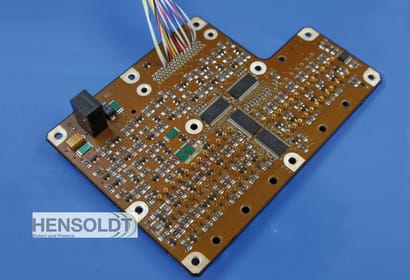Additive manufacturing offers obvious benefits for a range of industries, but perhaps none more so than aerospace and defense (A&D). In this two-part series, I will first list some of the challenges in the development of parts for the A&D industry. In part 2, I will discuss possible approaches to addressing these challenges via 3D-printed electronics to get innovative ideas off the ground quickly.
3D printing already is having a disruptive influence on the A&D market, with the ability to increase precision, print lightweight parts on the fly and save on development and manufacturing costs. In a recent example, US Naval Air Systems Command officials announced in June that they expect to be using additive manufacturing to print parts for certain popular military aircraft by next year.
But one area where 3D printing may have the greatest impact for these industries is in the ability to go beyond static parts and print actual electronic components in the form of 3D-printed circuit boards, to help A&D manufactures innovate faster, test more thoroughly and improve efficiency. With this capability, the day is not far off when it will be possible to print a new circuit board to replace a faulty one in the field – from a military installation overseas or on the International Space Station, for example.
Today, the global printed circuit board (PCB) market exceeds $60B, yet it largely remains mired in medieval manufacturing processes. PCB prototyping is a painstaking slow and expensive process, especially in the A&D industry where outsourcing usually means less efficiency and higher chances of failure.
Aerospace and defense product designers requiring PCB prototypes generally have them made off-site by specialist, clearance-rated sub-contractors. This leaves them the unfortunate choice of managing slow turnaround processes of two to three weeks, or having to accept very high development costs for a quick turn-around.
Even more frustrating, given the tight time-frames usually involved in development projects of this kind, is the high likelihood of multiple design iterations so that the PCB can be optimized from a circuit and system perspective. The risk of delays inherent in the design and prototyping process is such that this process often leads to very conservative PCB designs.
But perhaps the biggest drawback is that it can introduce a security threat for industries like A&D, where shipping out proprietary designs and IP to third-party prototyping firms puts sensitive – and sometimes classified – information at risk.
Fortunately, emerging 3D PCB printer technology is changing all that. With desktop 3D inkjet printers using specialty, conductive inks, designers can engage in rapid, on-site PCB prototyping. 3D printers can churn out sophisticated, fully functional prototypes in just hours, instead of the weeks it might take for off-site prototyping.
Conductive nano-particle inks allow for previously impossible precision on nearly any substrate; designs that once required drilling to make electronic connections between layers can be printed, layer-by-layer, with connections made as each new layer is added.
Early Days of Adoption
Today, the 3D-printed electronics market is about where regular 3D prototyping was seven years ago – in the very early stages of adoption but steadily starting to gain awareness. This is driven by a desire for accelerated time to market, development and manufacturing cost reductions and for creation of customized parts and complex design improvements, including new geometries to produce PCBs designs virtually impossible to make with traditional manufacturing methods.
With the obvious benefits of 3D printing, it is clear why printed circuit board (PCB) designers and electronics engineers are enthusiastic for it to replace some, if not all, of today’s traditional processes with in-house development of high-performance electronic device applications. This will not happen overnight, and it’s not likely to totally replace traditional manufacturing of electronics.
But we can expect 3D printing to shape the A&D products of tomorrow, enabling them to look and function completely differently. Just imagine the benefits, new PCB designs for fuel savings and more compact PCB designs to produce lighter weight, smaller parts for fuel savings.
This growth is largely dependent on the right combination of deposition technology, advanced material solutions, and software advancements. To succeed it will also require the discovery of applications where 3D-printed electronics can provide unmatched value in terms of speed, ROI, IP security for projects and design compared to traditional manufacturing. Another significant advantage of additive manufacturing for PCBs over traditional methods? It is a zero-waste process with minimal environmental impact.
Simon Fried
A co-founder of Nano Dimension, Simon Fried leads Nano Dimension’s USA activities and marketing for this revolutionary additive technology. With experience working in the US, Israel, and throughout Europe, he has held senior and advisory roles in start-ups in the solar power, medical device, and marketing sectors. Previously, Simon worked as a consultant on projects covering sales, marketing, and strategy across the automotive, financial, retail, FMCG, pharmaceutical, and telecom industries. He also worked at Oxford University researching investor and consumer risk and decision making.
